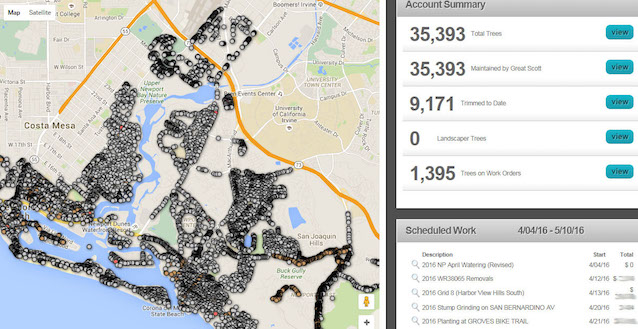With more than 100 employees, Great Scott Tree Service is one of the largest tree care companies in Orange County, California. Scott Griffiths founded the company 40 years ago and now has a client roster of commercial properties, universities, municipalities, golf courses and homeowner associations.
To help manage the thousands of trees the company cares for, Great Scott developed its own geographic information system (GIS) called TrimIt. This type of program is becoming more popular for tree care companies with large clients, such as cities. We talked with Griffiths about how the software works and how it’s beneficial to his company — and his clients.
Q: How does your proprietary GIS tree inventory system, TrimIt, work?
A: We go out to every single tree to input all of its information into the system including a photo, species, height, condition and location. Once in the database, its location is pinpointed on a Google Map, so we know its exact latitude and longitude coordinates. For example, one California city has 34,000 trees and each has its own record in TrimIt.
Q: How was it developed?
A: Our program was developed in-house by an ISA Certified Arborist with more than 10 years of experience in the tree inventory industry. Companies can use a third-party program, but they may have to pay licensing fees. It worked better for us to create our own.
Q: How does the system help with scheduling services?
A: It provides us a history of every tree inputted into the database, so we can use it to schedule services. When you’re working with a city, trees are typically on a three- or four-year trimming cycle. If a city asks when a certain part of town is set for a trim, I can look up that area and see it’s scheduled in two months.
Q: What else do you use it for?
A: We also use TrimIt for billing. When I send an invoice to a client for trimming 50 trees, we also send a map that shows a dot everywhere a tree was trimmed. The client can literally drive by the trees and double-check.
Q: How many of your clients use TrimIt?
A: Every one of our municipal clients use it. I estimate 65 to 70 percent of our clients use it. For the other 30 to 35 percent of our clients, we use bulk inventory, where trees are plotted as groups. For example, this parking lot has eight trees or this store front has 20 trees.
Q: How does this system benefit clients?
A: Municipalities have tens of thousands of trees. It helps everybody from the city manager down to the municipal arborist and the finance department. They can look at invoices from three years ago to see what trees were trimmed and what we charged them. Everybody has visibility to the part they need. As a public entity, this gives them great transparency.
Q: Is GIS inventory growing in a particular area?
A: It’s becoming more popular with homeowner associations, golf courses and retail clients. We’re seeing that if a client has a thousand or more trees, especially for homeowner associations, they’re turning toward a GPS inventory system.
This article contains third-party observations, advice or experiences that do not necessarily reflect the opinions of Vermeer Corporation, its affiliates or its dealers. Advice or suggestions provided in this article are statements of general applicability that may or may not apply to individual businesses, whose circumstances and operations may vary.
